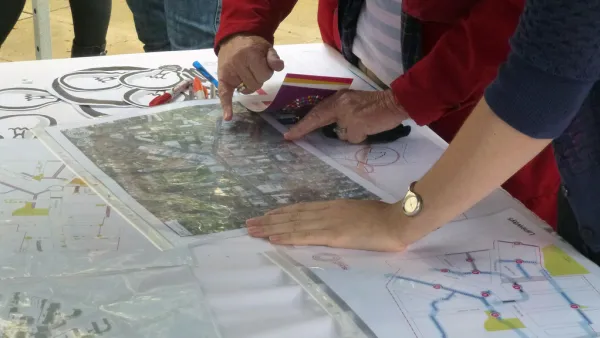For as often as the Gulf Coast and 9/11 debacles and their aftermaths have been analyzed, one discussion has been conspicuously missing: how starkly those events, natural and man-made, revealed the inability of planning today--however professionally designed, organized and regulated—to contend with the vagaries of circumstances and conditions out of its control.
For as often as the Gulf Coast and 9/11 debacles and their aftermaths have been analyzed, one discussion has been conspicuously missing: how starkly those events, natural and man-made, revealed the inability of planning today--however professionally designed, organized and regulated-to contend with the vagaries of circumstances and conditions out of its control. Indeed, the chaotic rebuilding processes that continue in the wake of these catastrophes have undermined public confidence in the discipline of urban planning/design. It appeared to idly witness the jurisdictional squabbling, and the institution of risk-averse and anti-urban safety/security measures that followed, such as 75-foot setbacks and concrete retaining or barrier walls. If Katrina and the World Trade Center are any indication, what we're making may well be the next disaster.
In the post 9/11 metropolis, fear and risk are openly and widely accepted as part of everyday urban life. We should have seen it coming, though, because for some time now, both planning and architecture have been practiced amidst an environment of increasing instability and uncertainty. As both planners and developers alike all too readily admit, political and economic circumstances fluctuate and change so rapidly today that by the time that a design proposal is realized, it is often already obsolete. A mere election can radically alter the objectives of a master plan if a challenger, with plans of his or her own, beats the incumbent who supported it. Hardly an alteration to the urban landscape can be made today, of any scale, that is not affected by such vagaries of circumstance. These include political (i.e. neighborhood) forces; ecological/climatic forces; regulatory forces; technological change; market forces; change of land use; even changes in knowledge (where the conditions don't change, but our understanding of them does).
So why, if our sand castles get kicked over or wiped out so often by a change in the tides, are not more urban designers, planners and architects exploring design and policy approaches that are more effective in contending with or adapting to such circumstances? Largely because we have failed to recognize that our effectiveness hinges on the ability to operate at the cusp between control and disorganization: to learn to rely less on fixed forms of regulation and more on behavior modification. As professionals, we have heretofore tended to dichotomize the two conditions, aligning ourselves with the former and against the latter, thereby artificially limiting ourselves from exploring "fuzzier," more flexible and self-regulating (or self-proliferating) planning strategies. If we learn anything from these recent catastrophes, it is that instead of having their hands on the dials which regulate form and land use, planners need to begin to treat the city instead in terms of the way it operates, as a machine for managing urban flows and stoppages--whether it be those of capital, traffic, nature, population etc. The alternative is to become increasingly irrelevant to how cities will determine themselves to operate anyway.
To begin with, rather than assuming stability and explaining change, we must assume change and explain stability. Needed are more elastic design strategies, ones capable of "surfing" or harnessing the highly turbulent and unpredictable evolution of the contemporary city. How to provide sufficient looseness with regard to future scenarios constitutes the principal paradox of urban development today. The development of more flexible and adaptive strategies is crucial, because even in the face of such uncertain conditions in the city today, there is still a need for a plan at the end of planning, a desire for progress even in the absence of utopian ambitions. Indeed, even if planning is not the answer for disaster, disaster may be the answer for planning. Just as it exposed the ineptitude of current planning and design methods, the radical break from the norm that defines urban crisis also provides an opportunity to make something new and useful of it--be it building, infrastructure, policy, or theory. (This was recently the case in Pakistan of all places, where the site of a catastrophic earthquake became a de facto public space, bringing together classes of people otherwise socially divided, leading to novel approaches to mass housing and community-building). Only by recovering their instrumentality will urban planning and design have a chance of not only maintaining their relevance, but indeed of surviving as practices altogether.

Analysis: Cybertruck Fatality Rate Far Exceeds That of Ford Pinto
The Tesla Cybertruck was recalled seven times last year.

National Parks Layoffs Will Cause Communities to Lose Billions
Thousands of essential park workers were laid off this week, just before the busy spring break season.

Retro-silient?: America’s First “Eco-burb,” The Woodlands Turns 50
A master-planned community north of Houston offers lessons on green infrastructure and resilient design, but falls short of its founder’s lofty affordability and walkability goals.

Test News Post 1
This is a summary

Analysis: Cybertruck Fatality Rate Far Exceeds That of Ford Pinto
The Tesla Cybertruck was recalled seven times last year.

Test News Headline 46
Test for the image on the front page.
Urban Design for Planners 1: Software Tools
This six-course series explores essential urban design concepts using open source software and equips planners with the tools they need to participate fully in the urban design process.
Planning for Universal Design
Learn the tools for implementing Universal Design in planning regulations.
EMC Planning Group, Inc.
Planetizen
Planetizen
Mpact (formerly Rail~Volution)
Great Falls Development Authority, Inc.
HUDs Office of Policy Development and Research
NYU Wagner Graduate School of Public Service



























